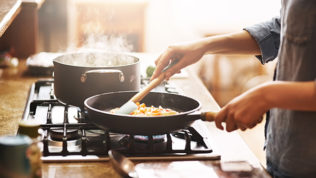With the dine-in restaurant world shut down, we are cooking more at home – and we have the grocery bills to prove it.
But with more cooking and more time being spent at home comes the very real potential for kitchen-related fires and burns, including to children.
It’s important to remember some key safety tips when cooking.
BEFORE COOKING
- A clean cooking environment is critical. Make sure before you start and after you finish that all surfaces are wiped clean and no ignitable food or grease is on the countertop.
- The No. 1 cause of kitchen fires is inattention. Fire can spread significantly in a short time. Whether you are cooking, roasting or frying, do not leave food unattended. If you leave the kitchen, turn off the stove.
- Random items close to the stove – such as plastic grocery bags, food packaging, oven mitts or dish towels – can quickly spread any fire. Keep these items away from the stove.
- Loose clothing could easily touch a gas or electric burner and catch on fire. Be aware of your sleeves, shirt ends or other flowing fabrics when working around your stove or oven.
- Preparation matters. Make sure you have a portable class B:C fire extinguisher mounted in the kitchen, and a working smoke detector near the kitchen. Have baking soda readily available to extinguish a fire.
- Outdoor cooking devices belong outdoors. Using outdoor grills or fryers inside your home increases the risk of fire or carbon monoxide poisoning.
WHILE COOKING
- Do not leave young children unattended near the stove or oven.
- Heat oil on medium vs. high to minimize the chance of fire or accident.
- Turn pot handles toward the back of the stove so they cannot be bumped or pulled over.
- Keep a pan lid or baking sheet nearby to use to cover the pan if it catches on fire.
- Don’t use metal in the microwave; sparks can easily turn into fire or can seriously damage your microwave.
AFTER COOKING
- Do not throw hot grease into the garbage can.
- Let the grease cool to minimize the chances of any fire.
IF YOU HAVE A FIRE
- Close the door of your oven or microwave and turn it off. The lack of oxygen will suffocate the flames.
- Use an oven mitt to place the lid on your cooking pan. The lack of oxygen will stop the flames. If safe to do so, move the pan off the burner. Turn off the stove.
- Grab the class B:C kitchen fire extinguisher if you can’t safely cover the cooking pan. Aim at the base of the fire and sweep side to side.
- Never use water to put out grease fires! Water repels grease and will spread the fire by splattering the grease. Instead:
- If the fire is small, cover the pan with a lid and turn off the burner.
- Throw lots of baking soda or salt on it. Never use flour, which is combustible and will make the fire worse.
- Smother the fire with a wet towel or large wet cloth.
Following safety procedures will help keep your kitchen a source of great meals and memories, rather than a fire.
MORE INFORMATION
- “Prevent Kitchen Fires” United States Fire Administration
https://www.usfa.fema.gov/downloads/pdf/publications/kitchen_fires_flyer.pdf - “Home Cooking Fires” National Fire Protection Association (November 2019)
https://www.nfpa.org//-/media/Files/News-and-Research/Fire-statistics-and-reports/US-Fire-Problem/Fire-causes/oscooking.pdf
This loss control information is advisory only. The authors assume no responsibility for management or control of loss control activities. Not all exposures are identified in this article.

